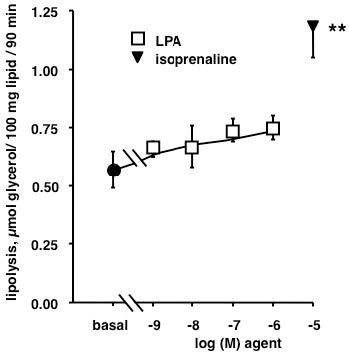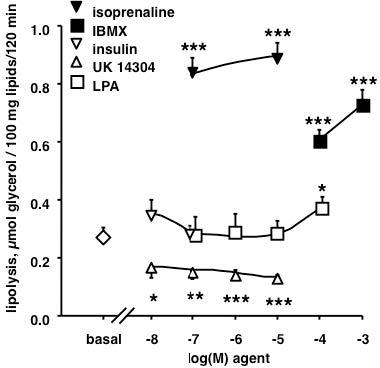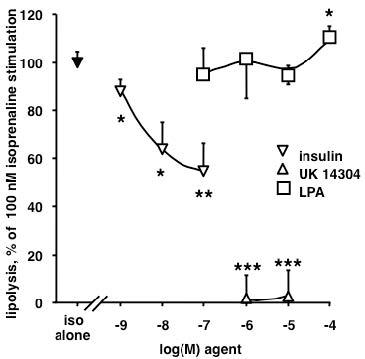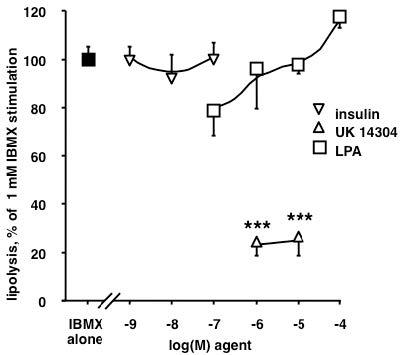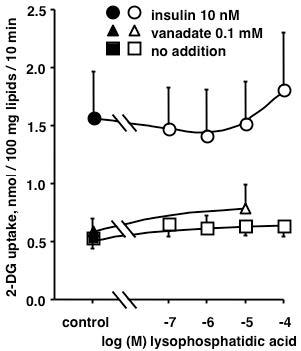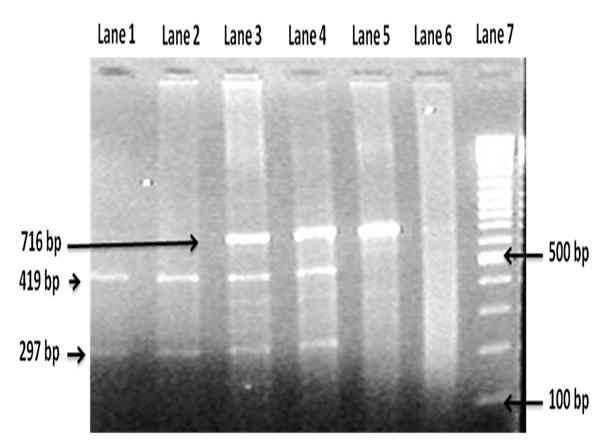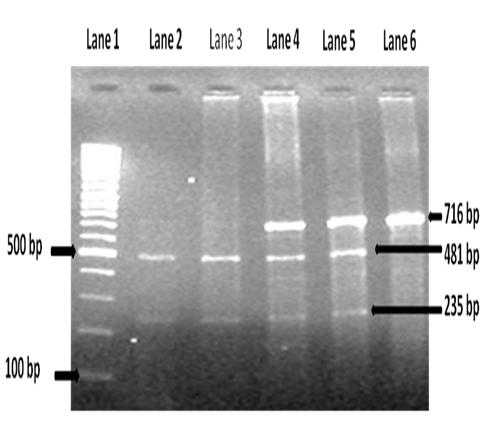1. Introduction
Among the bioactive phospholipids, lysophosphatidic acid (LPA) is considered as a remarkable growth factor in regards to its capacity to activate specific G-protein-coupled receptors named LPA1R to LPA6R [1,2] in various tissues. These membrane receptors are also known as endothelial differentiation G-protein-coupled receptors (EDG receptors) according to a previous nomenclature. Activation of these diverse receptors by LPA participates to the regulation of a wide range of cellular responses (proliferation, survival, motility, ion flux, secretion) and is essential for vasculature development [3,4]. Though the LPA found in plasma has diverse anatomical origins, the adipose tissue has been shown to be a major source since adipocytes produce this soluble phospholipid in their surrounding medium [5]. This peculiar production involves the hydrolysis of extracellular lysophosphatidylcholine (LPC) by a secreted lyso-phospholipase D currently named autotaxin (ATX) [6]. Soluble ATX is present in the blood stream where it generates a large proportion of the circulating levels of LPA. The precursor form of this circulating activity, namely the tissue-bound ATX, is synthesized in numerous organs, including brain, lymph nodes and adipose tissue. In the latter, the glycosylated enzyme ATX is released from adipocytes, catalyzes lysophosphatidic acid synthesis, which then induces preadipocyte proliferation. This increases the cell number within the fat depot, but does not necessarily expand lipid storage. Moreover, the ATX expression in adipose tissue is upregulated when obesity is associated with complications such as insulin-resistance [7,8]. These observations reported in animal models of obesity and morbid obese patients are in agreement with in vitro approaches demonstrating that activation of LPA1R, the most abundant LPA-receptor subtype expressed in adipose tissue, stimulates preadipocyte proliferation while it inhibits their differentiation into adipocytes [9,10]. The link between LPA production and adipose tissue development is supported by additional evidences. Mice lacking the LPA1R (LPA1R-KO) exhibited an increase in perigonadic fat mass with larger adipocytes compared to their wild type (WT) control, despite a decrease in food intake [11]. However, these LPA1R-KO mice were less sensitive than WT to a high-fat diet obesogenic challenge, and diverse underlying mechanisms were proposed to explain this phenotype such as a role of LPA on food intake regulation through the modulation of leptin production and/or action.
Similarly, disruption of LPA signaling was obtained by reducing by half its circulating levels in mice with adipocyte-specific invalidation of ATX (FATX-KO). Mice with such impaired adipose tissue-dependent synthesis of ATX became obese without increasing their food intake, suggesting that LPA exerts a continuous inhibitory effect on fat mass expansion [12]. Moreover, the FATX-KO mice had improved glucose tolerance and a higher expression of the transcription factor PPARγ2 in adipose depots [12]. This asked to verify whether normal or elevated LPA levels can impair adipose tissue insulin sensitivity. The influences of sustained LPA activity on inflammation and fibrosis in adipose tissue, have been subsequently investigated and pointed out that, together with other cytokines or lipid products, LPA could be considered as a pro-inflammatory mediator that contributes to insulin resistance [13,14]. In a context of growing number of evidences for a role of ATX/LPA axis in obesity and its complications, only little is known regarding the possible direct and immediate autocrine actions of the LPA in adipocytes. In contrast to ATX, LPA1R is more abundant in cells from the stroma-vascular fraction of adipose tissue (preadipocytes, endothelial cells, immune cells) than in the adipocytes themselves [10]. This distribution has limited the search for direct interactions between LPA and lipid-laden, mature adipocytes. Recently, it has been observed that LPA exerts a deleterious effect on glucose disposal through a reduction of plasma insulin [13]. Our goal was therefore focused to compare the intrinsic properties of LPA that could be classified as short-term, direct, or short-lasting, on insulin-regulated processes in mature fat cells, namely antilipolysis and glucose uptake stimulation.
The mean LPA plasma levels (around 0.1 µM in man) led us to test firstly inframicromolar doses of LPA on the triglyceride breakdown (lipolysis) in human adipocytes. Complete dose-responses of LPA, ranging from 100 nM to 100 µM were also tested since LPA was supposed to be present in higher amounts in the milieu surrounding adipocytes than in plasma, as a result of its continuous synthesis by ATX, once released by fat cells.It was compared whether LPA actions might resemble to those of recognized lipolytic, antilipolytic, or lipogenic agents of reference. Lastly, since the LPA precursor, lysophosphatidylcholine (LPC), has been suggested to interfere with a primary amine oxidase [15], which is highly expressed in adipocytes [16], and the substrates of which (benzylamine, methylamine) are endowed with antilipolytic properties [17], we verified in human adipose tissue preparations whether such interplay also occurs for LPA.
2. Materials and Methods
2.1. Patients and adipose tissue biopsies
Samples of subcutaneous abdominal adipose tissue were obtained from a total of 23 non-obese women undergoing reconstructive surgery at Rangueil hospital, Toulouse (France): mean body mass index 26.0 ± 0.9 kg/m2, mean age 41 y (range: 26-57). The surgically removed pieces of human adipose tissue were placed in sterile plastic box, and immediately transported to the laboratory following agreement of the INSERM guidelines and ethic committee. The pieces were immediately subjected to collagenase digestion at 37 °C to obtain freshly isolated adipose cells, while small samples were stored at −80°C until amine oxidase assays.
2.2. Preparation of mature adipocyte suspensions
Pieces of adipose tissue were grossly minced in Krebs-Ringer salt solution pH 7.5 containing 15 mM sodium bicarbonate, 10 mM HEPES and 3.5% of fat-depleted bovine serum albumin (KRBHA), and 5.5 mM glucose, except for the cell preparations further used for glucose uptake assays, in which glucose was replaced by 2 mM pyruvate. After digestion with 1 mg/mL collagenase type II for approximately 45 min under agitation, buoyant adipocytes were separated by filtration through a 300 μm mesh-screen and carefully washed in fresh medium to obtain adipocyte suspensions as previously described [18]. The average amount of fat cells suspended in fresh KRHBA and distributed as 400µL volume into the incubation vials was determined as previously reported [19], and given as mg of cellular lipids/vial. The same procedure was applied for rat adipocytes, which were used at 16.8 ± 0.5 mg lipids/400 µL for preliminary tests. A total of 10 male Wistar rats were purchased at Charles River (L’Arbresle, France) and were sacrificed according to INSERM guidelines for adipocyte preparation as previously detailed [20].
2.3. Assessment of lipolytic activity
All the steps of filtration and separation and incubation of the mature adipocytes were performed in disposable plasticwares at 37°C, as previously described [18]. All the tested agents were added to 400 µL of fat cell suspension in KRBHA under the form of 4 µL of a dilution extemporaneously done to reach the final indicated concentration. The agents were incubated with the fat cells at 37°C under constant, gentle, shaking during 60, 90 or 120 min as specified in Results. Incubations were stopped by placing the incubation tubes on ice. Once the buoyant adipocytes were frosted at the surface, 150µL of medium were removed for glycerol release determination by spectrophotometric measurement at 340nm, 40min at room temperature after the addition of 1.5mL of the following detection mixture: 0.6 mM NAD, 1.4mM ATP, 0.2 M glycine, 1 M hydrazine, in the presence of 15 unit/mL rabbit muscle glycerol phosphate dehydrogenase, and 0.6unit/mL glycerokinase, pH 9.8, as previously described [19].
2.4. Glucose transport assay
[3H]-2-deoxyglucose uptake (2-DG) into freshly isolated human fat cells was determined at 37 °C in KRBHA (with 2 mM pyruvate replacing glucose as fuel supply) as previously described [21]. Briefly, an isotopic dilution of 2-DG was added at a final concentration of 0.1 mM (approximate 1, 300, 000 dpm/vial) to 400 µL of cell suspension after 45 min preincubation with the tested agents The samples were incubated for additional 10 min and then stopped with 100 µL of 100 µM cytochalasin B. Aliquotes (200 µL) of shaken cell suspension were immediately centrifuged in microtubes containing dinonyl phthalate of density 0.98 g/mL, which allowed to separate the adipocytes from the buffer, as previously described [22] After this separation of internalized hexose, the intact fat cells (upper part of the tubes) were placed in scintillation vials and the incorporated radioactivity was counted. The extracellular 2-DG present in the cell fraction was determined using adipocytes whose transport activity was previously blocked by cytochalasin B at time 0. It did not exceed 1% of the maximum 2-DG uptake in the presence of insulin and was subtracted from the assays.
2.5. Amine oxidase activity
Homogenates were prepared with freshly thawed subcutaneous adipose tissue samples by using homogenizer Tissue Master-125 (Omni International, Kennesaw, GA, USA) for approximate 30 s. Amine oxidation was then determined by incubating 0.5 mM [14C]-tyramine or [14C]-benzylamine during 30 min at 37 °C together with homogenates (approximate 100 µg proteins) in the absence or the presence of reference inhibitors, as already described [19]. The vehicle used for the dissolution of the phospholipids (1% fatty free bovine serum albumin in PBS) was ineffective in altering radiolabelled amine oxidation. Protein quantification was performed using DC Protein Assay kit (BioRad, Hercules, CA, USA).
2.6. Chemicals
Lysophosphatidic acid (Oleoyl-L-α-lysophosphatidic acid sodium salt, purity ≥99%) was from Avanti Polar (Alabaster, USA). (−)-isoprenaline hydrochloride, isobutylmethylxanthine (IBMX), collagenase type II (C-6885), bovine insulin, bovine albumin, tyramine, benzylamine, amine oxidase inhibitors, and other reagents were obtained from Sigma-Aldrich (Saint Quentin Fallavier, France). [3H]-2-deoxyglucose was from Perkin Elmer (Boston, MA, USA), [14C]-tyramine was from Sigma-Aldrich and [14C]-benzylamine from Amersham.
2.7. Statistical analysis
Results are presented as means ± standard error of the means (SEM). Statistical analysis for comparisons between LPA and respective control used Student’s t test. ns: non significantly different from control.
3. Results
3.1. Effects of LPA on glycerol release by rat adipocytes
Dose-response to LPA was first investigated on rat adipocytes in the presence of the β-adrenergic pan-agonist isoprenaline [23]. Lipolysis was maximally activated by 10 µM of this reference lipolytic agent, reaching a five-fold increase over basal values (Figure 1). The chosen dose of isoprenaline to combine with LPA was 10 nM since it was submaximal and increased basal lipolysis by a three-fold factor, allowing the detection of any further activation or inhibition elicited by a tested agent. However, in these conditions, LPA remained inactive from 100 nM to 10 µM, and did not elicit a classical sigmoidal dose-response.
We further tested whether LPA was modulating basal, stimulated or inhibited states of lipolysis in rat adipocytes. Figure 1 shows that 1 µM LPA had no effect on spontaneous or 10 nM isoprenaline-activated glycerol release. By contrast, 100 nM insulin and 1 mM tyramine hampered the β-adrenergic activation by 55 and 80%, respectively. In addition, the antilipolytic responses to insulin or tyramine were unaltered by 1 µM LPA (Figure 1). Thus, in rat adipocytes there was no apparent effect of LPA on lipolysis sensitivity to reference lipolytic and antilipolytic agents.
Next, LPA was tested on the lipolysis stimulated by isobutylmethylxanthine (IBMX 1 mM), a phosphodiesterase blocker that increases cAMP and lipolysis independently from β-adrenergic receptor activation. Again, no alteration of IBMX lipolytic effect was found with LPA, when tested at 10 and 100 µM (representing 105.0 ± 8.4 and 114.7 ± 9.5% of IBMX alone, ns, n = 5, not shown). This preliminary approach showed that LPA does not alter lipolytic responsiveness in rat adipocytes. Then, LPA was tested on freshly isolated human fat cells.
3.2. Influence of LPA on basal lipolysis in human adipocytes
First tests of LPA effect on human adipocytes were performed on 90-min incubation. LPA was inactive on glycerol release when added at 1 nM, and remained inactive up to 1 µM, in spite of exhibiting a trend to increase glycerol release (Figure 2). However, the elevated basal values of glycerol release, together with the relatively modest stimulation by the β-adrenergic agonist (2.3 ± 0.4 fold activation of basal, n = 7) found in human adipocytes, prompted us to use slightly different incubation conditions. Changing the batch of bovine serum albumin and of collagenase during the phase of adipocyte preparation, and enlarging the incubation period up to 120 min allowed us to obtain lower spontaneous lipolytic activity. Further analyses were therefore performed in these conditions on 15 additional adipocyte preparations obtained from non-obese women.
Figure 3 shows that in this second set of experiments, LPA tended to increase lipolytic activity at supramicromolar doses. A limited, significant increase was observed only with 100 µM LPA. The reference lipolytic agents, isoprenaline and IBMX, stimulated glycerol release to a larger extent, and again, the maximal lipolysis was reached with 10 µM isoprenaline. Among the tested antilipolytic agents, insulin was unable to lower basal activity, even when present at 100 nM. In contrast, the α2-adrenergic agonist UK 10304 (also known as brimonidine) dose-dependently inhibited basal lipolysis, from 10 nM to 10 µM. Further conditions were tested, mainly consisting in combining the phospholipid with a submaximal dose of isoprenaline, as reported above for rat adipocytes.
3.3. Influence of LPA on isoprenaline lipolytic effect in human adipocytes
Human adipocytes were incubated 2 hours with LPA or with antilipolytic agents while isoprenaline was present at 100 nM only during the last hour. This resulted in a submaximal β-adrenergic activation of lipolysis that wasdose-dependently impaired by insulin (Figure 4). This submaximal isoprenaline stimulation was totally abolished when α2-adrenoceptors were activated by 1 µM UK 14304. By contrast, LPA did not hamper such lipolysis activation. At 100 µM, LPAeven increased the action of the β-adrenergic agonist (Figure 4).
3.4. Influence of LPA on non-adrenergic stimulation of lipolysis
Lipolytic activity of human adipocytes was then activated by IBMX, a non-selective inhibitor of phosphodiesterases. Only the α2-adrenergic agonist UK 10304 exhibited strong antilipolytic properties while neither insulin nor LPA were significantly altering IBMX-dependent activation (Figure 5).The effects of 0.1µM LPA tended to be inhibitory (p=0.11). Increasing LPA doseled to enhance IMBX-induced lipolysis, though to a proportion that remained under the limits of significance: at 100 µM, LPA + IBMX was 119±10% versus 100±7% for IBMX alone, p = 0.09).
We tested another lipolysis activation method, consistingin the removal of adenosine from the incubation medium by adenosine deaminase.Since adenosine exerts a continuous negative feedback on glycerol release [24], the resulting lipolysis stimulation reached 0.84 ± 0.06 µmol glycerol/100 mg lipids/120 min. LPA did not alter such stimulation (not shown).
It has been reported that LPA favors the release of hydrogen peroxide from various cell types [25]. Since multiple effects of hydrogen peroxide are improved in the presence of vanadium [19], we tested whether 100 µM sodium vanadate could enhance or reveal the effect of 10 µM LPA on lipolysis. There was no influence on isoprenaline-activated lipolysis (not shown). Similarly, the values of IBMX-stimulated lipolysis were unaltered in the presence of LPA with and without vanadate: 0.61 ± 0.06 and 0.58 ± 0.06 µmol glycerol/100 mg lipids/120 min, respectively (ns, n = 7).
3.5. Influence of LPA on basal and stimulated glucose transport
Figure 6 shows that our human fat cell preparations were highly sensitive to insulin since 10 nM of the pancreatic hormone induced a three-fold increase in basal 2-deoxyglucose uptake. There was not any significant effect of LPA on basal or insulin-stimulated glucose uptake when the phospholipid was added from 0.1 to 100 µM. Vanadate did not stimulate glucose uptake at 100 µM and remained ineffective when tested in combination with 10 µM LPA (Figure 6).
3.6. Putative interaction between LPA and adipocyte amine oxidases
The LPA precursor and ATX substrate LPC has been suggested to be a competitive activator increasing the activity of human lung semicarbazide-sensitive amine oxidase (SSAO) [15]. Since SSAO is highly expressed in human adipocytes [16], and since its substrates (e.g. benzylamine) are able to activate glucose uptake [19], we tested the interaction of LPC and LPA with such primary amine oxidase expressed by human adipocytes. Neither LPA nor LPC at 50 µM were able to modify the oxidation of 0.5 mM of [14C]-benzylamine by human adipose tissue homogenates, which was totally abolished by 1 mM semicarbazide, therefore SSAO-dependent (not shown). Lastly, it was verified whether the monoamine oxidase (MAO) activity, also found in human adipocytes [26] could be modulated by LPC or LPA. Again, [14C]-tyramine oxidation remained unaltered in the presence of 50 µM LPC or LPA, while it was sensitive to pargyline (MAO inhibitor) and resistant to semicarbazide (not shown).
4. Discussion
In this study focused on the short-term effects of LPA on adipocytes, micromolar doses of the phospholipid, tested under the molecular form of oleoyl-L-α-lysophosphatidic acid, were ineffective, irrespective of the response studied in rat and human adipocytes: lipolysis, antilipolysis or glucose transport. However, supramicromolar doses of LPA exhibited a modest but immediate stimulatory effect on lipolysis in human subcutaneous adipocytes. At 100 µM, LPA was lipolytic on its own and increased isoprenaline action. The lack of clear-cut sigmoidal dose-response curves for LPA on mature fat cells suggested that the bioactive phospholipid interacted with various receptors and/or targets. Accordingly, fully differentiated, lipid-laden adipocytes are known to express lower levels of LPA1R than preadipocytes [10].
To our knowledge, the only reported study on the effect of LPA on adipocyte lipolytic activity, showed that doses higher than 100 µM of phosphatidic acid and of LPA inhibited isoprenaline or IBMX-induced lipolysis in hamster adipocytes [27]. Working within the 1nM-100µM range, we did not found such antilipolytic action for LPA in rat or human adipocytes. LPA did not enhance (rat) or mimic (human) the insulin antilipolytic effect, except a trend to limit the IBMX-induced lipolysis at the lowest dose tested. Of note, the α2-adrenergic antilipolytic effect was much more efficient than the insulin one in human subcutaneous fat cells, since it impaired basal, IBMX- and isoprenaline-stimulated lipolysis, whereas the pancreatic hormone only counteracted the β-adrenergic stimulation. This is in agreement with the high expression of α2-adrenergic receptors on human subcutaneous adipocytes [28]. The antilipolytic effect of high doses of tyramine, recently described in murine adipocytes to be partly dependent on MAO and SSAO activities [29], was also unaffected by LPA. In contrast, we observed that 100 µM LPA tended to activate basal or stimulated glycerol release. The increase was modest compared with the response to reference lipolytic agents. However, this was consistent with the LPA-induced increase of cAMP reported in other cellular models [30], and with the lipolytic effect of another bioactive phospholipid, sphingosine-1-phosphate, in rat adipocytes [31]. However, this was in apparent disagreement with the already described coupling of the LPA1R to Gi and to the small GTPase Rho [32], or with several pertussis toxin-sensitive effects of LPA [2,33,34]. Yet, the short-term LPA action was expected to be antilipolytic, as it is the case for agonists of the numerous Gi-coupled receptors expressed on adipocytes (e.g. α2-adrenergic receptors) [35]. Conversely, the modest lipolytic activation that we observed in mature adipocytes was somewhat in accordance with the recognized actions of LPA/ATX axis, which has been described to increase pre-adipocyte proliferation, and to decrease their differentiation into lipid-laden adipocytes [10]. Indeed, such adipocyte differentiation, generally studied in vitro, requires increase in glucose uptake/consumption to trigger de novo lipogenesis, i.e. the transformation of the energy from the culture medium, essentially under the form of hexoses, into intracellular triglycerides that accumulate in lipid droplets. Our observations do not bring any evidence of an enhancement of hexose transport by LPA in mature adipocytes. In this view, they are consistent with the LPA inhibitory effect on adipocyte differentiation [10].
Our findings contrast with the previously reported LPA1R-dependent stimulation of glucose uptake by LPA in 3T3-L1 preadipocytes [36] or in Xenopus oocytes [37]. Nevertheless, LPA has been already reported to inhibit glucose uptake in primary rat brain astrocytes [38], indicating that the balance of the activation of its various receptor subtypes might have a different resulting action on hexose transport, depending on the cell type. Since mature adipocytes express lower levels of LPAIR than preadipocytes [10], one could propose that difference in receptor expression may explain the apparent discrepancy of LPA effect on glucose transport [36].
Moreover, our results indicate that LPA does not acutely impair the short-term effects of insulin in adipocytes, namely lipolysis inhibition and glucose transport activation. Therefore, in vivo the long-term LPA actions that worsen glucose homeostasis in high fat diet obese mice [13] are probably not mediated by an obliteration of insulin responsiveness but rather by a limitation of insulin secretion, as already reported [13,39]. Whatsoever, both in vitro and in vivo findings converge towards the fact that LPA does not favor adipose tissue accretion while it promotes fibrosis [14]. Although contrasting with the originally proposed PPARγ agonist properties [40], which have not been confirmed yet, our unpretentious interpretations help in enhancing the comprehension of the LPA role on adipose tissue physiology: the phospholipid does not exhibit short-term insulin-like action in human fat cells.
It must be noted that LPA generally does not exceed 0.1 µM in human plasma, while the microenvironment of adipocytes, which is a site of continuous release of ATX that metabolizes LPC into LPA, can be locally exposed to higher concentrations of the phospholipid. Though the exact range level of such extracellular LPA remains unknown, our negative test with LPA regarding allosteric SSAO stimulation renders unlikely a direct contribution of the bioactive lipid in the regulation of adipose SSAO activity. At this stage, it is of value to note that in the db/db mouse, SSAO is substantially increased in adipose tissue with obesity and especially diabetes, as a result of upregulated expression [41] rather than by post-traductional activation by soluble co-activator. Thus, while LPA has been demonstrated to play an important role in the remodeling of the extracellular matrix in several organs, and constitutes a therapeutic target for the treatment of fibrosis [42] or tumorigenesis [43], there is no clear evidence that LPA directly influences SSAO, an enzyme involved in the cross-linking of extracellular matrix components [44]. In addition, our experiments did not confirm the stimulatory nature of LPC towards human SSAO, previously proposed from experiments performed with the enzyme expressed in lung [15], and LPC doses close to its human plasma concentration, i.e. around 200μM [45]. In addition, it should be noted that: 1) in vitro antilipolytic effect of tyramine was unaltered by LPA in rat adipocytes; 2) the lack of LPA action on glucose transport was not modified by vanadate. Since the mechanism of action of these two agents is related with SSAO activity, their lack of interplay with LPA does not argue for a close relationship between the phospholipid and the amine oxidase. Finally, plasma LPA increases with obesity and its complications [46] and ATX expression is up-regulated in the visceral fat depots of obese individuals [8], while plasma LPC [45] and adipose SSAO activity [47] have not been found to increase with body mass index in humans. These various clinical observations do not indicate that obesity-related changes in LPC/ATX/LPA axis are associated with an alteration of SSAO activity.
5. Conclusion
In conclusion, from our in vitro observations in both rat and human adipocytes, it can be proposed that inframicromolar LPA doses do not have direct action on mature adipocytes. Supramicromolar doses of LPAthat may occur within adipose tissue when ATX increases with obesity, are facilitating lipolysis and participating to a limited proportion of the multiple paracrine effects of the bioactive phospholipid in various organs and functions. These moderate direct effects of LPA in human adipocytes tip the balance in favor of triglyceride breakdown rather than assisting fat accumulation.
Acknowledgments
This study was partly supported by recurrent grant from INSERM to Unit 1048. We would like to thank the staff of Plastic Surgery Dpt. of Rangueil Hospital (Toulouse, France) for facilitating access to post-surgical wastes. Brimonidine (UK 14304) was a generous gift from late Dr. Hervé Paris (I2MC, Toulouse). Authors thank Anais Briot for editing English version.
Conflict of Interest
There is no conflict of interest to declare for any author of this work.









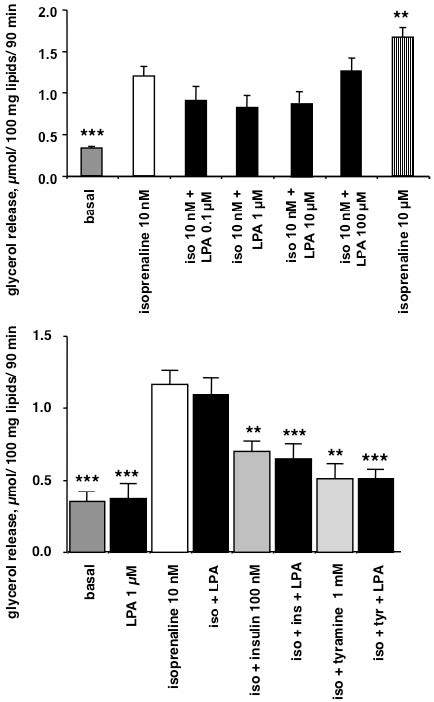
 DownLoad:
DownLoad: 